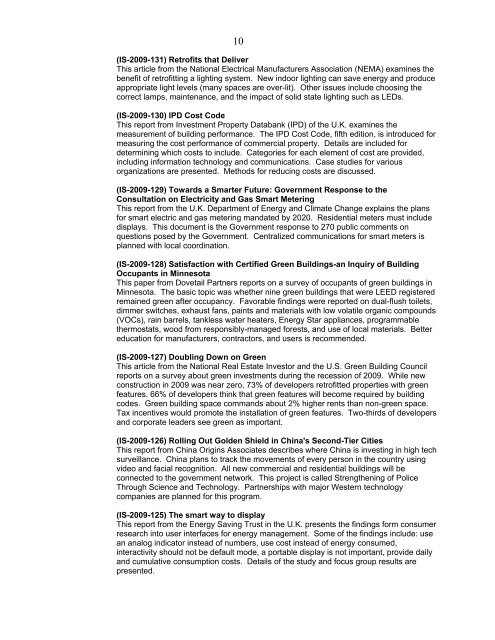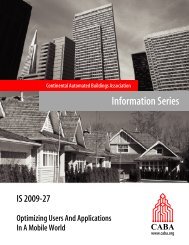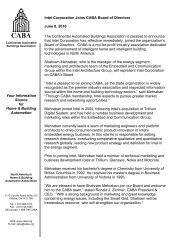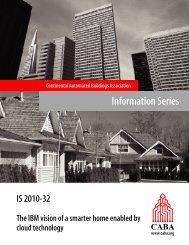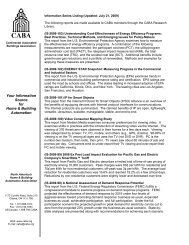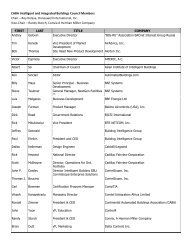Your Information Source for Home & Building Automation
Your Information Source for Home & Building Automation
Your Information Source for Home & Building Automation
You also want an ePaper? Increase the reach of your titles
YUMPU automatically turns print PDFs into web optimized ePapers that Google loves.
10<br />
(IS-2009-131) Retrofits that Deliver<br />
This article from the National Electrical Manufacturers Association (NEMA) examines the<br />
benefit of retrofitting a lighting system. New indoor lighting can save energy and produce<br />
appropriate light levels (many spaces are over-lit). Other issues include choosing the<br />
correct lamps, maintenance, and the impact of solid state lighting such as LEDs.<br />
(IS-2009-130) IPD Cost Code<br />
This report from Investment Property Databank (IPD) of the U.K. examines the<br />
measurement of building per<strong>for</strong>mance. The IPD Cost Code, fifth edition, is introduced <strong>for</strong><br />
measuring the cost per<strong>for</strong>mance of commercial property. Details are included <strong>for</strong><br />
determining which costs to include. Categories <strong>for</strong> each element of cost are provided,<br />
including in<strong>for</strong>mation technology and communications. Case studies <strong>for</strong> various<br />
organizations are presented. Methods <strong>for</strong> reducing costs are discussed.<br />
(IS-2009-129) Towards a Smarter Future: Government Response to the<br />
Consultation on Electricity and Gas Smart Metering<br />
This report from the U.K. Department of Energy and Climate Change explains the plans<br />
<strong>for</strong> smart electric and gas metering mandated by 2020. Residential meters must include<br />
displays. This document is the Government response to 270 public comments on<br />
questions posed by the Government. Centralized communications <strong>for</strong> smart meters is<br />
planned with local coordination.<br />
(IS-2009-128) Satisfaction with Certified Green <strong>Building</strong>s-an Inquiry of <strong>Building</strong><br />
Occupants in Minnesota<br />
This paper from Dovetail Partners reports on a survey of occupants of green buildings in<br />
Minnesota. The basic topic was whether nine green buildings that were LEED registered<br />
remained green after occupancy. Favorable findings were reported on dual-flush toilets,<br />
dimmer switches, exhaust fans, paints and materials with low volatile organic compounds<br />
(VOCs), rain barrels, tankless water heaters, Energy Star appliances, programmable<br />
thermostats, wood from responsibly-managed <strong>for</strong>ests, and use of local materials. Better<br />
education <strong>for</strong> manufacturers, contractors, and users is recommended.<br />
(IS-2009-127) Doubling Down on Green<br />
This article from the National Real Estate Investor and the U.S. Green <strong>Building</strong> Council<br />
reports on a survey about green investments during the recession of 2009. While new<br />
construction in 2009 was near zero, 73% of developers retrofitted properties with green<br />
features. 66% of developers think that green features will become required by building<br />
codes. Green building space commands about 2% higher rents than non-green space.<br />
Tax incentives would promote the installation of green features. Two-thirds of developers<br />
and corporate leaders see green as important.<br />
(IS-2009-126) Rolling Out Golden Shield in China's Second-Tier Cities<br />
This report from China Origins Associates describes where China is investing in high tech<br />
surveillance. China plans to track the movements of every person in the country using<br />
video and facial recognition. All new commercial and residential buildings will be<br />
connected to the government network. This project is called Strengthening of Police<br />
Through Science and Technology. Partnerships with major Western technology<br />
companies are planned <strong>for</strong> this program.<br />
(IS-2009-125) The smart way to display<br />
This report from the Energy Saving Trust in the U.K. presents the findings <strong>for</strong>m consumer<br />
research into user interfaces <strong>for</strong> energy management. Some of the findings include: use<br />
an analog indicator instead of numbers, use cost instead of energy consumed,<br />
interactivity should not be default mode, a portable display is not important, provide daily<br />
and cumulative consumption costs. Details of the study and focus group results are<br />
presented.


